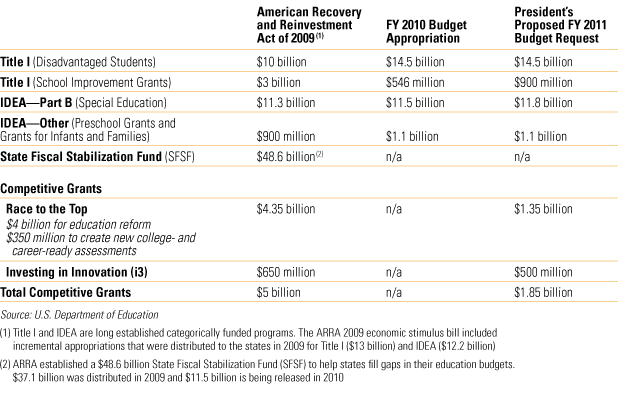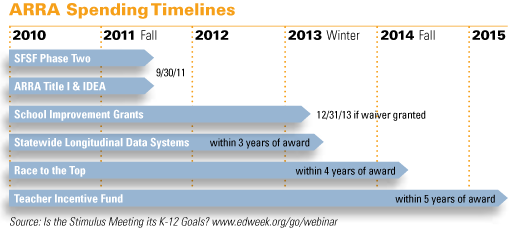Federal Funding for Key
Education Programs
Federal dollars continue to flow into the U.S. education system. No major actions
will be taken on the U.S. Department of Education’s FY 2011 budget or
reauthorization of the Elementary and Secondary Education Act (ESEA), also
known as No Child Left Behind (NCLB), until Congress reconvenes in fall 2010.
The passage of the FY 2011 education budget and reauthorization of
ESEA are independent of each other. If reauthorization of the ESEA does
not occur in 2010, we expect to see the passage of a FY 2011 budget
to fund the programs of the U.S. Department of Education. The budget
is likely to include initiatives outlined in the budget proposal submitted
to Congress in February 2010. The President’s proposed budget incorporates
funding for several programs first introduced in the American
Recovery and Reinvestment Act of 2009 (ARRA). Congress has shown
some bipartisan interest in funding these programs, which include Race
to the Top and Investing in Innovation. If Congress does not finalize the
budget before the beginning of the new fiscal year, starting on October 1,
2010, Congress can maintain funding through a series of continuing
resolutions, which has happened in the past.
“Blueprint” for Reauthorizing ESEA
On March 13, 2010, the U.S. Department of Education released the Administration’s
“blueprint” for reauthorizing ESEA. The proposed reforms include:
Standards
In order to receive Title I
funds, states will be required
to align their mathematics
and English/language arts
(ELA) standards with
college- and career-ready
expectations, either through
adoption of the Common
Core Standards or through
individual state action, with
incentives for Common Core.
Assessments
States will be required to
continue assessments in
English/
language arts (ELA),
math, and science as
provided under NCLB. In
addition to funding support
for these existing state
testing programs, the
reauthorization blueprint
proposes new formula
grants for improved
assessments and competitive
grants for Common
Core assessments.
Accountability
States will be required to
make annual accountability
determinations for all
schools and districts, with
transparent, disaggregated
reporting. The Annual Yearly
Progress (AYP) measurements
currently prescribed
by NCLB will be eliminated;
accountability will be based
on growth and progress,
with the goal of ensuring
college- and career-readiness
for all students by 2020.
Race to the Top
and
Investing
in Innovation
The proposed budget would
continue federal funding for
state comprehensive reforms
and local innovation.
Federal Funding for Key Education Programs
ARRA Competitive Grants
Race to the Top
Investing in Innovation (i3)
The ARRA economic stimulus
bill gave the U.S. Secretary of
Education authority to establish
two competitive grant programs
designed to help states and local
schools drive educational results.
All winners will be announced and
all awards will be distributed by
September 30, 2010, the end of
fiscal year 2010.
Race to the Top (RTTT) is a U.S.
Department of Education program
designed to promote comprehensive
school reform. Of the $4.35 billion
in RTTT funds, the Department is
awarding $4 billion directly to states
that develop the most promising
plans to advance education reform.
RTTT will also provide $350 million
in competitive funding to multi-state
consortia to create new college and
career-ready assessments. The
Administration has proposed to
continue the education reform
program by requesting $1.35 billion
in the FY 2011 budget.
Investing in Innovation will make
competitive investments in cutting edge
ideas aimed at producing the
next generation of school reforms.
Applicants could receive funding for
scale-up grants, validation grants, and
development grants. Grant recipients
would be required to match their federal
awards with other private dollars,
and to demonstrate how they would
sustain their activities after the end of
the federal award period. ARRA
provided $650 million in funding. The
Administration has proposed to
continue the program by requesting
$500 million in the FY 2011 budget.
Update on
Competition
Phase 1: The Department of Education received
41 state applications. In April 2010, Delaware
and Tennessee were chosen as the winners.
Phase 2: 19 applicants have been announced
as finalists. The winners will be announced in
September 2010.
On August 4, 2010 the Department of Education
announced that 49 school districts, nonprofit
education organizations, and institutions of
higher education were selected from 1,698
applicants for the i3 program. To receive a
share of the $650 million in i3 grants, the
winning applicants must secure a commitment
for a 20% private sector match by
September 8, 2010.
Common Core State Standards & Assessments
In June 2010, the National Governors
Association Center for Best Practices and
the Council of Chief State School Officers
released a set of state-led education
standards, known as the Common Core
State Standards. Designed to establish
clear and consistent goals for learning
that will help prepare America’s children
for success in college and work, the
standards are:
| Aligned with college and work expectations |
| Include rigorous content and application of
knowledge through high-order skills |
| Build upon strengths and lessons of current
state standards |
| Informed by other top performing countries,
so that all students are prepared to succeed
in the global economy and society |
| Evidence- and research-based |
Timeline:
Each state will follow its own procedures
and processes for adoption of
the Common Core State Standards.
Applicants that declared their intention
to adopt the standards by August 2010
earned extra points in the Race to the
Top grant competition.
Later in 2010 the Department of
Education will award $350 million to
multi-state consortia with winning
proposals for developing new assessments
based on the Common Core
Standards. Present indications are that
testing development work will begin
in late 2010 or perhaps early 2011, and
that the Common Assessments will be
implemented from 2012 through 2014.
How McGraw-Hill May Benefit
| New assessment and instructional materials: The Common Core movement has favorable
implications for new assessment and instructional
materials. There is an expectation
that there will be more new purchasing as
states adopt materials that incorporate the
new standards |
| Less need for customization: As states
adopt the new Common Core Standards, the
demand for customized material may also
be reduced, which could translate into cost
savings in content development |


